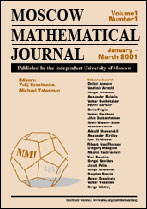|
This article is cited in 23 scientific papers (total in 23 papers)
The Young bouquet and its boundary
Alexei Borodinabc, Grigori Olshanskidce
a Massachusetts Institute of Technology, USA
b California Institute of Technology, USA
c Institute for Information Transmission Problems, Moscow, Russia
d Independent University of Moscow, Russia
e National Research University Higher School of Economics, 20 Myasnitskaya Ulitsa, Moscow 101000, Russia
Abstract:
The classification results for the extreme characters of two basic “big” groups, the infinite symmetric group $S(\infty)$ and the infinite-dimensional unitary group $U(\infty)$, are remarkably similar. It does not seem to be possible to explain this phenomenon using a suitable extension of the Schur–Weyl duality to infinite dimension. We suggest an explanation of a different nature that does not have analogs in the classical representation theory.
We start from the combinatorial/probabilistic approach to characters of “big” groups initiated by Vershik and Kerov. In this approach, the space of extreme characters is viewed as a boundary of a certain infinite graph. In the cases of $S(\infty)$ and $U(\infty)$, those are the Young graph and the Gelfand–Tsetlin graph, respectively. We introduce a new related object that we call the Young bouquet. It is a poset with continuous grading whose boundary we define and compute. We show that this boundary is a cone over the boundary of the Young graph, and at the same time it is also a degeneration of the boundary of the Gelfand–Tsetlin graph.
The Young bouquet has an application to constructing infinite-dimensional Markov processes with determinantal correlation functions.
Key words and phrases:
Young graph, Gelfand–Tsetlin graph, entrance boundary, infinite symmetric group, infinite-dimensional unitary group, characters, Gibbs measures.
Received: October 19, 2011; in revised form September 18, 2012
Citation:
Alexei Borodin, Grigori Olshanski, “The Young bouquet and its boundary”, Mosc. Math. J., 13:2 (2013), 193–232
Linking options:
https://www.mathnet.ru/eng/mmj495 https://www.mathnet.ru/eng/mmj/v13/i2/p193
|

| Statistics & downloads: |
| Abstract page: | 422 | | References: | 110 |
|




 Contact us:
Contact us: Terms of Use
Terms of Use
 Registration to the website
Registration to the website Logotypes
Logotypes








 Citation in format
Citation in format 
